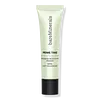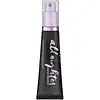What's inside
What's inside
 Key Ingredients
Key Ingredients

 Benefits
Benefits

 Concerns
Concerns

 Ingredients Side-by-side
Ingredients Side-by-side

Water
Skin ConditioningDecyl Cocoate
EmollientCoco-Caprylate/Caprate
EmollientCaprylic/Capric Triglyceride
MaskingTriheptanoin
Skin ConditioningKaolin
AbrasivePropanediol
SolventAvena Sativa Kernel Oil
Skin ConditioningCetearyl Olivate
Cellulose
AbsorbentOleyl Erucate
EmollientSqualane
EmollientSorbitan Olivate
EmulsifyingC9-12 Alkane
SolventDilinoleic Acid/Butanediol Copolymer
Chamomilla Recutita Flower Extract
MaskingHelianthus Annuus Seed Oil
EmollientTocopherol
AntioxidantBisabolol
MaskingSalicyloyl Phytosphingosine
Skin ConditioningPentaerythrityl Tetra-Di-T-Butyl Hydroxyhydrocinnamate
AntioxidantSulfur
AntiseborrhoeicHydrogenated Palm Glycerides Citrate
EmollientZinc Ricinoleate
Magnesium Aluminum Silicate
AbsorbentCetearyl Alcohol
EmollientCetyl Palmitate
EmollientGlycerin
HumectantSorbitan Palmitate
EmulsifyingEthylene/Propylene/Styrene Copolymer
Xanthan Gum
EmulsifyingSorbitan Oleate
EmulsifyingCastor Oil/Ipdi Copolymer
Acacia Senegal Gum
MaskingMica
Cosmetic ColorantButylene/Ethylene/Styrene Copolymer
Phenoxyethanol
PreservativeCI 77163
Cosmetic ColorantCI 77289
Cosmetic ColorantCI 77288
Cosmetic ColorantZinc Oxide
Cosmetic ColorantWater, Decyl Cocoate, Coco-Caprylate/Caprate, Caprylic/Capric Triglyceride, Triheptanoin, Kaolin, Propanediol, Avena Sativa Kernel Oil, Cetearyl Olivate, Cellulose, Oleyl Erucate, Squalane, Sorbitan Olivate, C9-12 Alkane, Dilinoleic Acid/Butanediol Copolymer, Chamomilla Recutita Flower Extract, Helianthus Annuus Seed Oil, Tocopherol, Bisabolol, Salicyloyl Phytosphingosine, Pentaerythrityl Tetra-Di-T-Butyl Hydroxyhydrocinnamate, Sulfur, Hydrogenated Palm Glycerides Citrate, Zinc Ricinoleate, Magnesium Aluminum Silicate, Cetearyl Alcohol, Cetyl Palmitate, Glycerin, Sorbitan Palmitate, Ethylene/Propylene/Styrene Copolymer, Xanthan Gum, Sorbitan Oleate, Castor Oil/Ipdi Copolymer, Acacia Senegal Gum, Mica, Butylene/Ethylene/Styrene Copolymer, Phenoxyethanol, CI 77163, CI 77289, CI 77288, Zinc Oxide
Water
Skin ConditioningButylene Glycol
HumectantPolyacrylamide
Ethylhexyl Palmitate
EmollientGlycerin
HumectantC13-14 Isoparaffin
EmollientPhenoxyethanol
PreservativeCaprylyl Glycol
EmollientPullulan
Laureth-7
EmulsifyingTocopheryl Acetate
AntioxidantTetrahexyldecyl Ascorbate
AntioxidantSilica Dimethyl Silylate
EmollientNannochloropsis Oculata Extract
HumectantCarbomer
Emulsion StabilisingSodium Lactate
BufferingPotassium Sorbate
PreservativeTriethanolamine
BufferingSodium Benzoate
MaskingLitchi Chinensis Pericarp Extract
Skin ConditioningPolysorbate 20
EmulsifyingSodium Hyaluronate
HumectantHexylene Glycol
EmulsifyingPalmitoyl Tripeptide-1
Skin ConditioningPalmitoyl Tetrapeptide-7
Skin ConditioningWater, Butylene Glycol, Polyacrylamide, Ethylhexyl Palmitate, Glycerin, C13-14 Isoparaffin, Phenoxyethanol, Caprylyl Glycol, Pullulan, Laureth-7, Tocopheryl Acetate, Tetrahexyldecyl Ascorbate, Silica Dimethyl Silylate, Nannochloropsis Oculata Extract, Carbomer, Sodium Lactate, Potassium Sorbate, Triethanolamine, Sodium Benzoate, Litchi Chinensis Pericarp Extract, Polysorbate 20, Sodium Hyaluronate, Hexylene Glycol, Palmitoyl Tripeptide-1, Palmitoyl Tetrapeptide-7
Alternatives
Ingredients Explained
These ingredients are found in both products.
Ingredients higher up in an ingredient list are typically present in a larger amount.
Glycerin is already naturally found in your skin. It helps moisturize and protect your skin.
A study from 2016 found glycerin to be more effective as a humectant than AHAs and hyaluronic acid.
As a humectant, it helps the skin stay hydrated by pulling moisture to your skin. The low molecular weight of glycerin allows it to pull moisture into the deeper layers of your skin.
Hydrated skin improves your skin barrier; Your skin barrier helps protect against irritants and bacteria.
Glycerin has also been found to have antimicrobial and antiviral properties. Due to these properties, glycerin is often used in wound and burn treatments.
In cosmetics, glycerin is usually derived from plants such as soybean or palm. However, it can also be sourced from animals, such as tallow or animal fat.
This ingredient is organic, colorless, odorless, and non-toxic.
Glycerin is the name for this ingredient in American English. British English uses Glycerol/Glycerine.
Learn more about GlycerinPhenoxyethanol is a preservative that has germicide, antimicrobial, and aromatic properties. Studies show that phenoxyethanol can prevent microbial growth. By itself, it has a scent that is similar to that of a rose.
It's often used in formulations along with Caprylyl Glycol to preserve the shelf life of products.
Water. It's the most common cosmetic ingredient of all. You'll usually see it at the top of ingredient lists, meaning that it makes up the largest part of the product.
So why is it so popular? Water most often acts as a solvent - this means that it helps dissolve other ingredients into the formulation.
You'll also recognize water as that liquid we all need to stay alive. If you see this, drink a glass of water. Stay hydrated!
Learn more about Water